Sergey Karjakin first finalist: Carlsen and Duda will tie-break tomorrow
Monday, August 2nd 2021 – Afternoon’s such as today are a joy for chess fans. Aggressive openings, hard-fought middlegames, great endgame technique and of course amiable companionship. So interesting that FIDE President Arkady Dvorkovich keenly followed the games at the start of the round, before returning to his duties at the important FIDE Council Meeting, which is also being held these days in Sochi.
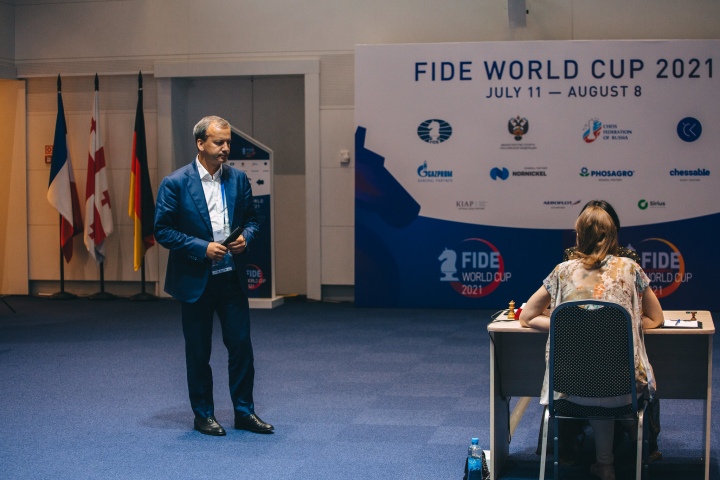
In the first semi-final between GM Jan-Krzysztof Duda (2738) and GM Magnus Carlsen (2847), Poland’s number one opened with 1.e4 and the World Champion went for an open game. Soon the game evolved into one of the many anti-Marshall variations of the Ruy Lopez with 8.a4, which Carlsen had already faced a few days ago in his game against Bacrot.
Possibly fearing some dangerous home preparation, Carlsen deviated with the less common 8…Rb8 (instead of 8…Bb7), which Duda was definitely not expecting, as he took nearly ten minutes for his next move.
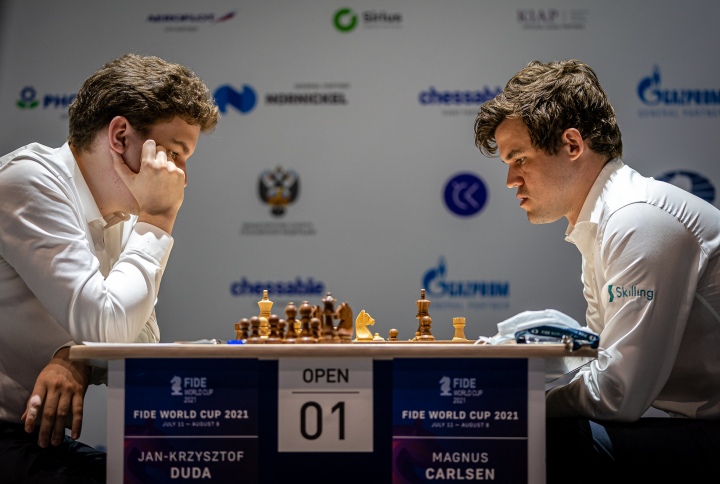
The game spiced up when Carlsen went for 9…d5, going for a Marshall Gambit type of position. Duda picked up the gauntlet and captured the pawn. After 17…g5 it was obvious to everybody that Carlsen had it all worked out: he was playing very fast and Duda was falling behind on the clock.
Prudently, Duda decided to exchange queens and the game transitioned into an equal endgame, with an extra pawn for White compensated by Black’s bishop pair and development. Although we were not able to find any games with the actual position, this type of endgame normally ends in a draw. White generally gives back the pawn to keep the balance, or opposite-colored bishop endgames often appear.

However, unexpectedly in pure Marshall spirit, Duda sacrificed his rook for a knight and a pawn. With two pawns for the exchange, it was clear that Duda couldn’t be worse but did he have the advantage?
Magnus demonstrated that the draw was always there. A hard-fought game, but nevertheless both of them will return tomorrow to battle it out in what will be a very exciting tie-break.
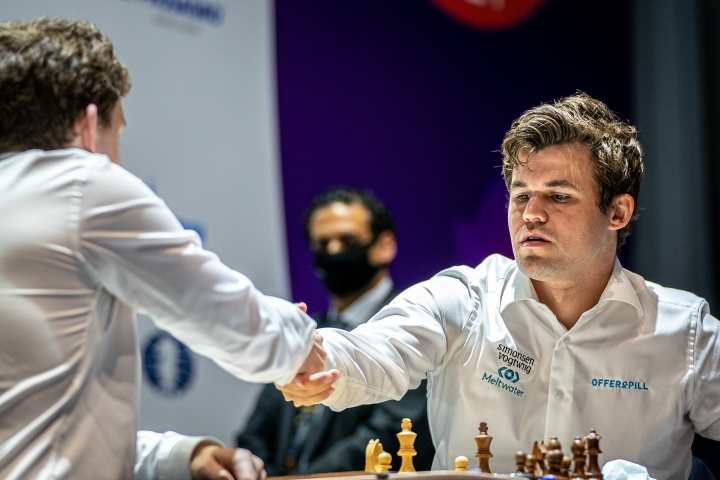
In the second semi-final, between Russian top players GM Sergey Karjakin (2757) and GM Vladimir Fedoseev (2696), the opening was also the Ruy Lopez, although in this case, Fedoseev chose the solid Zaitsev variation, quite content with the famous draw by repetition that occurs after 11.Ng5 Rf8 12.Nf3 Re8.
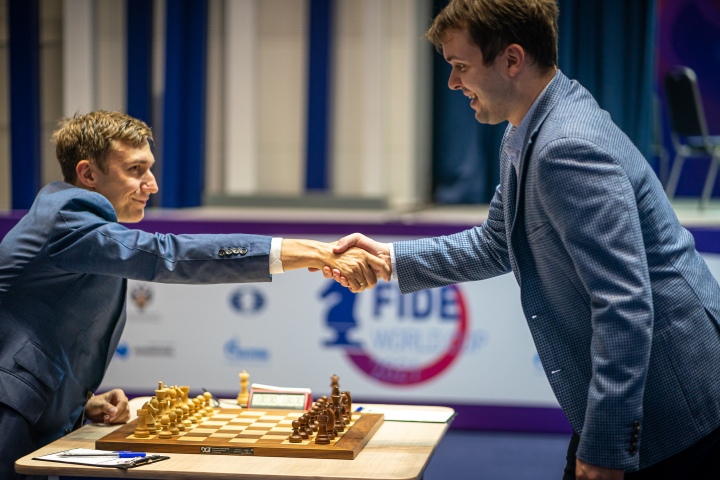
However, no one expected Karjakin to back down so early, and therefore 11.Nb-d2 was the main continuation. The turning point in the opening was move thirteen, when Fedoseev chose 13…d5 – played several times by Alexander Morozevich – instead of the main line 13…Nb8.
Both players were blitzing out their moves until Fedoseev pushed 19…f5. Karjakin went into the tank and after twenty-five minutes of deep thought came up with the novelty 20.h4, trying to improve on the games between Tari-Vidit (2018) and Oparin-Morazevich (2015). The idea is to control Black’s kingside expansion.
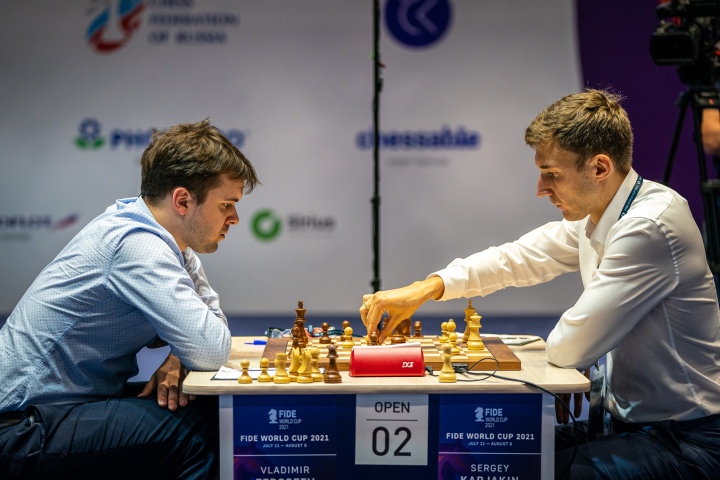
This might have taken Fedoseev by surprise, as soon after he blundered with 21…Rf8? allowing White to take the initiative with 24.e6!, which vacates the e5 square for a minor piece.
Fedoseev didn’t react in the best way and soon he was under serious pressure, the main threat being f3!, expelling the knight from the center and activating White’s hidden bishop on c2.
In desperado mode, Fedoseev initiated a series of exchanges beginning with a knight sacrifice on f2, but Karjakin had it all under control. After 31.d5 it became clear that Karjakin would be playing his second World Cup final: he won the title on Baku in 2015.
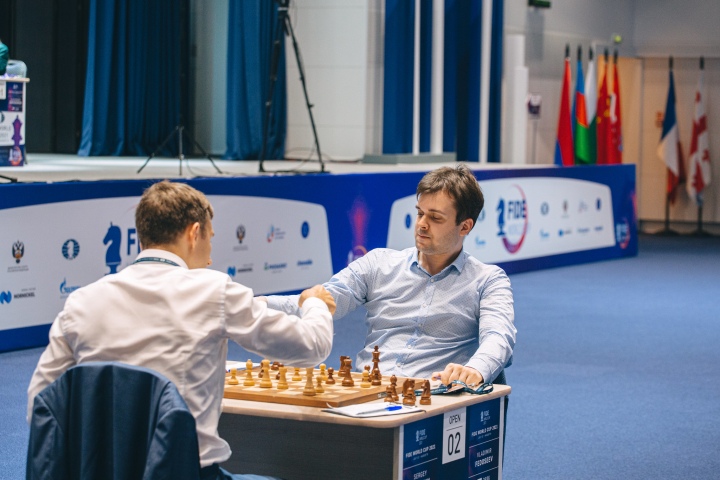
After the game, Karjakin was kind enough to give us his views on the game and who he prefers in the final: Duda or Carlsen?
After yesterday’s defeat, GM Aleksandra Goryachkina (2596) was in a must-win situation. Although she lost with the French Defence against GM Alexandra Kosteniuk (2472) in 2018, she decided to give it a second chance today.

Kosteniuk deviated from that previous game with 3.Nd2 and Goryachkina went for 3…c5, her main weapon against the Tarrasch variation. On move nine, Goryachkina tried 9…b6, instead of 9…Nc5, which was her choice against Kashlinskaya in 2019, a game which she went on to win.
She had prepared this move having seen an even older game which Kosteniuk played in 2013 against Jovana Rapport in the European Championship. Did Kosteniuk recall the game? Hard to know. One can only speculate on such things.
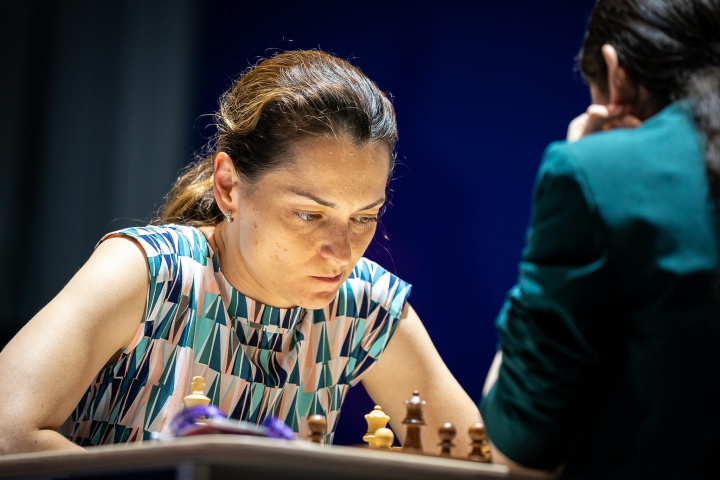
In any case, 12…Rc8 was Goryachkina’s novelty and after a few moves the game was totally unbalanced: Black’s development was decent, but her king would have to stay in the center for the rest of the game. Obviously, this kind of unbalanced middlegame would clearly favour Goryachkina.
Kosteniuk had a lot on the line. She prudently decided to play it safe, avoiding unnecessary risks, and timely exchange of queen’s and rook’s nipped Goryachkina’s counterplay in the bud.
The endgame was academic: opposite-side coloured bishops and equal pawns. The game was heading to a draw but Goryachkina over-pressed and ended up in a clearly lost queen ending. However, Kosteniuk graciously offered a draw, which her opponent accepted.
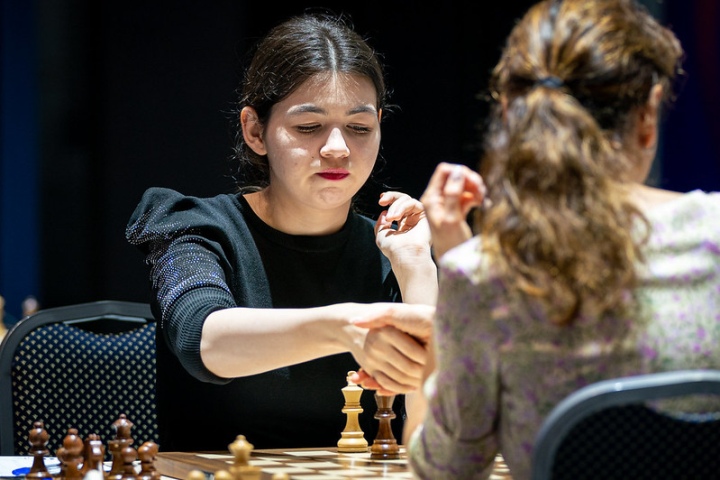
In the final women’s World Cup interview, a very happy Alexandra Kosteniuk gave us her thoughts on the match and her overall tournament success.
In the match for the third and fourth place in the Women’s World Cup, China’s GM Tan Zhongyi (2511) repeated the Petroff Defence and GM Anna Muzychuk (2527), representing Ukraine, went for the unambitious 5.Bd3 side-line.

White could have obtained the bishop pair with 12.Nxe7+ but she decided that Black’s development was more than enough compensation. After twenty moves the position was equal and resembled more an exchange French defence than a Petroff. White had the two bishops but Black’s strong knight on e4 was impressive.
Slightly worse, Muzychuk offered a move repetition on move twenty-seven with 27.Bd1 and 28.Bc2. However, Tan Zhongyi declined and waited for a better moment to force the simplification.

The ending was clearly better for the Chinese player – her minor pieces were clearly better – but Muzychuk defended tenaciously and a draw was agreed on move forty-nine. Tomorrow’s tie-break will decide who takes third place on the podium.
The full tournament tree, live games and PGN files can be found on the World Cup website alongside a great amount of other interesting information such as daily videos, a complete photo collection and other useful data.
Text: Michael Rahal, FIDE Press Officer press@fide.com
Photo: Eric Rosen and Anastasiia Korolkova
About the tournament:
Scheduled to take place from July 12th (Round 1) to August 6th (finals), the 2021 FIDE World Cup will gather together in Sochi (Russia) 309 of the world’s best chess players, with 206 of them playing in the Open World Cup (and 103 participants in the first-ever Women’s World Cup.
The top two finishers in the tournament, aside from World Champion Magnus Carlsen who is also participating, will qualify for the 2022 Candidates Tournament, in addition to winning the 110.000 USD first prize (80.000 USD for the runner-up).
Organisers: International Chess Federation (FIDE), Chess Federation of Russia, Russian Ministry of Sports, and Government of Krasnodar Krai.
Partners:
Gazprom – general partner
Nornickel – general partner
PhosAgro – general partner
Chessable – event’s partner
Aeroflot – CFR’s partner


